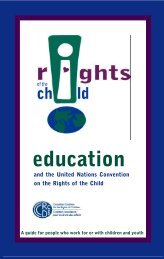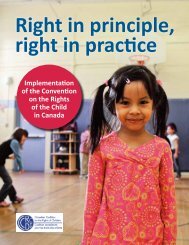Poste - Canadian Coalition for the Rights of Children
Poste - Canadian Coalition for the Rights of Children
Poste - Canadian Coalition for the Rights of Children
You also want an ePaper? Increase the reach of your titles
YUMPU automatically turns print PDFs into web optimized ePapers that Google loves.
C A N A D I A N C O A L I T I O N F O R T H E R I G H T S O F C H I L D R E N<br />
Practice refers to <strong>the</strong> application or implementation <strong>of</strong><br />
legislation and policy. Measured here is <strong>the</strong> extent to<br />
which <strong>the</strong> spirit <strong>of</strong> <strong>the</strong> legislation or policy is upheld.<br />
Included in this category are fluctuations in funding to<br />
relevant programs. Statistics related to <strong>the</strong> impact or effect<br />
are indicators <strong>of</strong> practice. Especially relevant to this<br />
category is <strong>the</strong> Convention’s general principle concerning<br />
non-discrimination. A universal act, guideline or policy<br />
may be applied unequally to persons because <strong>of</strong> race,<br />
gender, socio-economic status, etc. Practice does not<br />
necessarily reflect government policy, but can be <strong>the</strong><br />
result—desired or undesired—<strong>of</strong> that policy.<br />
Statistics and Research provide a situational analysis <strong>of</strong> a<br />
given area, beyond governmental practice and policy.<br />
Relevant statistics might include rates <strong>of</strong> poverty, crime,<br />
literacy, child neglect and school completion. To be valid,<br />
<strong>the</strong> research must follow accepted practices <strong>of</strong> research<br />
and data collection. This category could include<br />
international and comparative statistics. Statistics and<br />
research may reflect a certain “activity level” in an area <strong>of</strong><br />
study, where <strong>the</strong> absence <strong>of</strong> statistics/research may mean a<br />
lack <strong>of</strong> interest on <strong>the</strong> part <strong>of</strong> government, <strong>the</strong> research<br />
community, <strong>the</strong> public, etc.<br />
Public Opinion reflects moods, trends and perceptions <strong>of</strong><br />
a given population. It influences legislation, policy,<br />
practice and <strong>the</strong> entire political process in many ways.<br />
Compared to <strong>the</strong> media or expert opinion, it is intended to<br />
be broadly representative, as opposed to anecdotal, and<br />
relatively free <strong>of</strong> interpretation. For our purposes, relevant<br />
sources could include public opinion polls, election results<br />
and focus groups.<br />
O<strong>the</strong>r Relevant Resources include o<strong>the</strong>r significant<br />
sources <strong>of</strong> in<strong>for</strong>mation on <strong>the</strong> given topic. These include<br />
reports and opinions <strong>of</strong> non-governmental organizations,<br />
advocacy organizations, academics, practitioners and<br />
political parties.<br />
Jurisdictions make up <strong>the</strong> horizontal axis <strong>of</strong> <strong>the</strong> grid. They<br />
are divided into <strong>the</strong> following two categories:<br />
Federal Jurisdiction refers to <strong>the</strong> powers which are<br />
outlined in Section 91 <strong>of</strong> <strong>the</strong> Constitution Act, as well as<br />
all o<strong>the</strong>r domains where <strong>the</strong> federal government maintains<br />
spending and legislative activity. This category includes<br />
<strong>for</strong>eign policy and <strong>of</strong>ficial development assistance.<br />
124<br />
Provincial/Territorial Jurisdictions refer to <strong>the</strong> powers<br />
as outlined by Section 92 <strong>of</strong> <strong>the</strong> Constitution Act, as well<br />
as all o<strong>the</strong>r domains where <strong>the</strong>se governments maintain<br />
spending and legislative activity. Included are municipal<br />
institutions, which are <strong>the</strong> responsibility <strong>of</strong> provinces as<br />
defined in Section 92.<br />
Voices <strong>of</strong> <strong>Children</strong><br />
While children could in<strong>for</strong>m <strong>the</strong> above seven categories/<br />
headings, <strong>the</strong> grid lens accommodates <strong>the</strong>ir “voices”<br />
throughout our process and without <strong>the</strong> constraints<br />
placed on o<strong>the</strong>r categories/headings. Relevant quotes<br />
from children can be drawn from <strong>the</strong>ir participation at<br />
focus groups, from first person narratives or testimonials,<br />
case studies, etc. This category is different from public<br />
opinion because it is not intended to be representative.<br />
Citations <strong>for</strong> this category could include name, age,<br />
city/town, province/territory and any o<strong>the</strong>r relevant<br />
background.<br />
PROCESS: Situational Analysis<br />
A situational analysis is written <strong>for</strong> each Convention<br />
article or grouping <strong>of</strong> relevant articles which reflects <strong>the</strong><br />
state <strong>of</strong> Canada’s children in relation to <strong>the</strong> rights in that<br />
article(s).<br />
PROTOCOL: Report Criteria<br />
Readable: Clearly expressed in language appropriate <strong>for</strong><br />
a report to <strong>the</strong> United Nations yet easily followed and<br />
understood by <strong>the</strong> general public including youth.<br />
Credible: Thoughtful, intelligent review <strong>of</strong> reliable<br />
sources.<br />
Accurate: Fully documents, verifies and cross-checks all<br />
references, sources <strong>of</strong> in<strong>for</strong>mation and data.<br />
Comprehensive: Synopsis <strong>of</strong> in<strong>for</strong>mation drawn from all<br />
sources as defined in <strong>the</strong> framework grid.<br />
Transparent: Reflects <strong>the</strong> contributions and input <strong>of</strong><br />
NGOs, experts and children.<br />
Holistic: Presents a perspective that captures <strong>the</strong><br />
nuances, subtleties, successes and contradictions that<br />
mirror <strong>the</strong> reality <strong>of</strong> <strong>the</strong> practice and implementation <strong>of</strong><br />
children’s rights in Canada.




